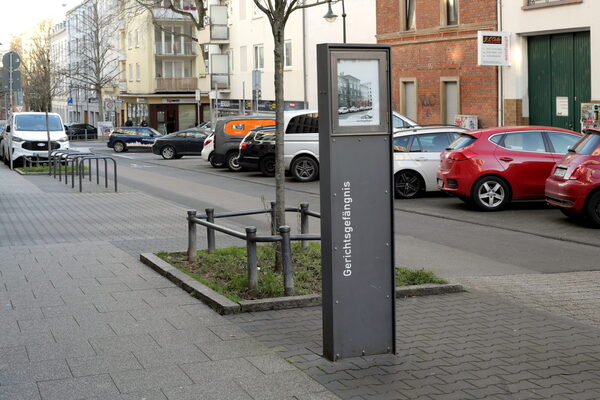Memorial to the court prison
The prison of the Wiesbaden district court was located at Albrechtstraße 29 until 1996. Persecutees of the regime and its opponents were imprisoned here during the Nazi era.
In 1875, the district court prison for 100 male and female prisoners was opened in Albrechtstraße. In the same year, a work barrack was built in the courtyard for the male prisoners. The neighboring court building was completed in 1897 as a new district and county court. There were also seven prison cells in the basement of the building.
After coming to power in 1933, the National Socialists immediately began the so-called Gleichschaltung. On March 31, 1933, local self-government was dissolved by the "Provisional Law on the Alignment of the Länder with the Reich". The National Socialists removed dissenting employees from the civil service.
The prosecution of opponents of the regime was the responsibility of the criminal senates of the higher regional courts and specially created special courts. The "People's Court", established in 1934, was the highest political criminal court responsible for the prosecution of "high treason" and "treason against the state", as well as "subversion of military power". The verdicts were final. The Reich Court Martial had also been in existence since 1936; this highest military court of the Nazi state not only prosecuted criminal cases of military relevance, but also those of political relevance to the state. All of these courts handed down many thousands of death sentences. In addition, countless people were sentenced to often long prison terms, after which they were often sent to one of the many concentration camps.
During the Nazi era, numerous political, religious and racially persecuted people were imprisoned in the court prison. For example, Jewish men were imprisoned here after the November Pogroms on November 10, 1938. Soon afterwards, in the presence of numerous spectators, they were loaded onto trucks to be deported to concentration camps in Buchenwald and Dachau.
At least 90 men and women were remanded in custody here under National Socialism for political criminal cases alone, including Georg Buch, the later Lord Mayor of Wiesbaden and President of the Hessian State Parliament, between 1941 and 1942. He was interned here for three quarters of a year. His Social Democratic resistance group, which had existed since 1933, had been exposed at the beginning of 1941. He served the two-and-a-half-year prison sentence imposed on him by the criminal senate of the Higher Regional Court in Kassel on March 13, 1942 in the Frankfurt-Preungesheim and Hanau prisons. He was then transferred to the Hinzert and Sachsenhausen concentration camps. He was only liberated in the spring of 1945.
Some of the Wiesbaden opponents of the regime who were arrested in the course of the Reich-wide "Gewitter" campaign following the failed attempt to overthrow the regime on July 20, 1944 were also temporarily detained in the court prison. These included the former workers' secretary and city councillor of the Center Party, Ferdinand Grün, who was re-elected to the city parliament for the CDU in 1946, as well as to the constitutional advisory state assembly of Greater Hesse and the Hessian state parliament.
In 1971, the former remand prison was finally closed. It was demolished in 1996.
Further information
City archive
Address
65197 Wiesbaden
Postal address
65029 Wiesbaden
Arrival
Notes on public transport
Public transportation: Bus stop Kleinfeldchen/Stadtarchiv, bus lines 4, 17, 23, 24 and 27 and bus stop Künstlerviertel/Stadtarchiv, bus line 18.
Telephone
- +49 611 313022
- +49 611 313977
Opening hours
Opening hours of the reading room:
- Monday: 9 a.m. to 12 p.m.
- Tuesday: 9 am to 4 pm
- Wednesday: 9 am to 6 pm
- Thursday: 12 to 16 o'clock
- Friday: closed
